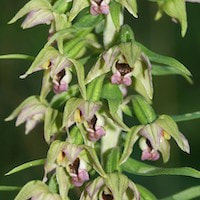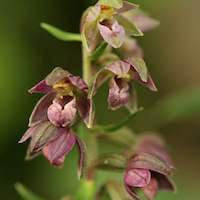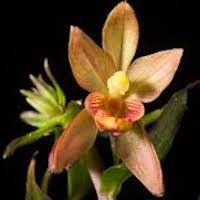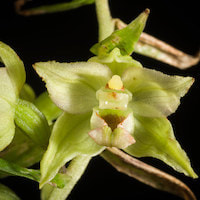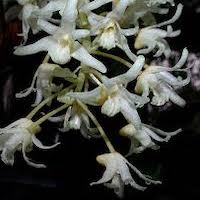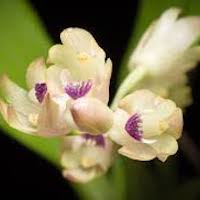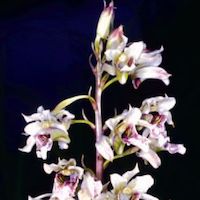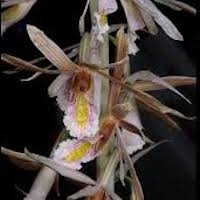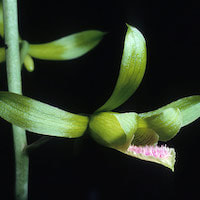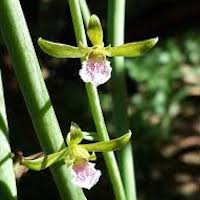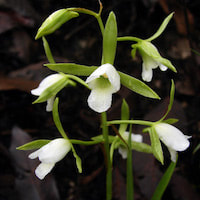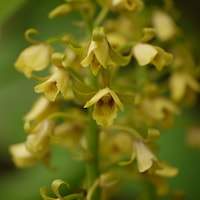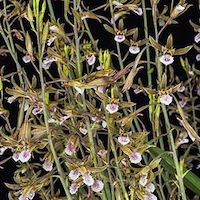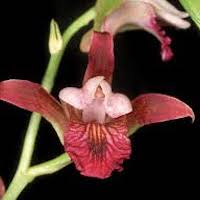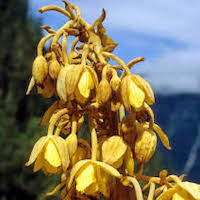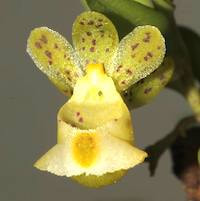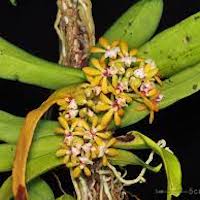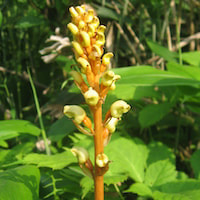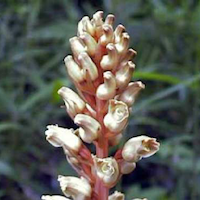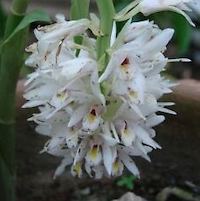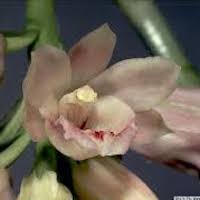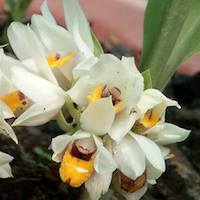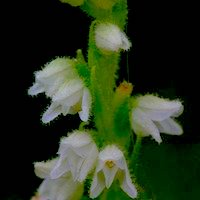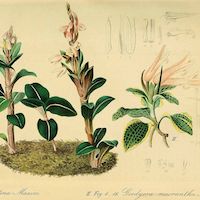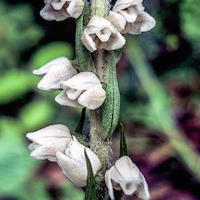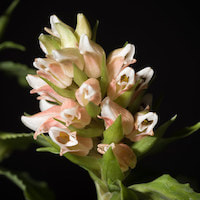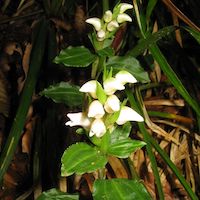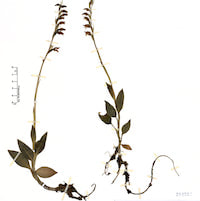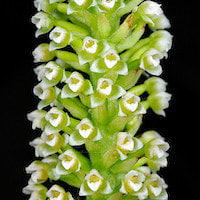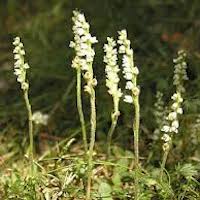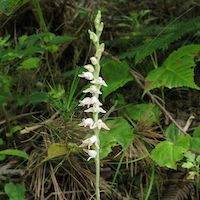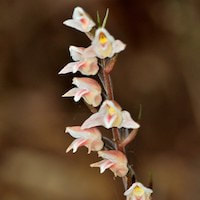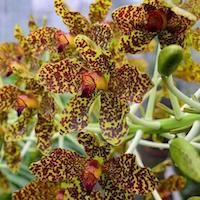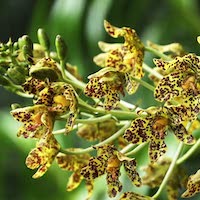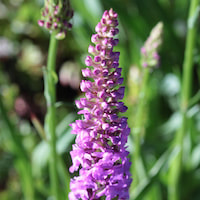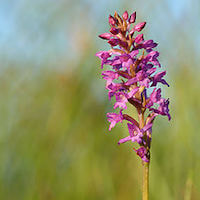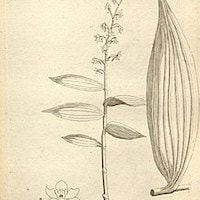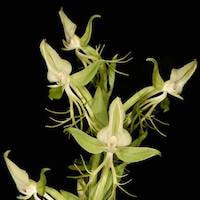|
Epipactis helleborine (L.) Crantz.
Chinese name: Xiaohuahuoshao Lan (small- flowered flaming orchid) Chinese medicinal name: Yezhulan An alpine, terrestrial orchid that grows across the northern temperate region in Europe and Asia, and in northwest Africa. “Bastard Helleborine” is a common European name for E. helleborine. Phytochemistry: It produces the glucoside, loroglossin, quercetin O-glycosides and Mannose-specific lectins with antiviral and antifungal activities. Alkaloid is present. Herbal Usage: In China, it is used as a tonic. The root is employed in TCM to clear heat from the lungs and liver, stop coughs, clear phlegm, and improve breathing and blood circulation. It is used in the treatment of trauma, sore throat, toothache and painful eyes. It regulates the flow of vital energy. It is also used to treat insanity, gout, headache and stomach disorders in Nepal. In Europe, it was an old folk remedy for gout. |
|
Epipactis helleborine, var. helleborine syn. Epipactis teneii Schltr.
Chinese name: Huiyanhuoshao Lan (grey rock flaming orchid), Huoshao Lan (flaming orchid) It is widespread throughout Europe, and also occurs in Pakistan and Nepal. Herbal Usage: The medicinal plant is collected from Yunnan, although the species and this variety is widely distributed throughout the temperate regions of the northern hemisphere. In TCM it is principally employed as a tonic. The entire plant is used to clear heat from the lungs and liver, and to stop coughs and clear phlegm, improve blood circulation, relieve toothache, diarrhea, backache and to treat snake bites. Juice of the roots is administered to treat insanity and gout in Nepal. |
|
Epipactis mairei Schltr.
Common name: Dayehuoshao Lan (big flower flaming orchid) Other names (at Emei Shan): Shan chu hua Chinese medicinal name: Xiaozihanxiao An attractive, terrestrial orchid that flowers in June and July in China and until August in the Himalayas. Usage: The plant is used as a tonic in Chinese herbal medicine. A paste made from the vegetative portion is applied to burns. It dissolves extravasated blood and improves the circulation. The medicinal plant is collected from Gansu, Shanxi, Hunan, Hubei, Sichuan, Yunnan and Xizang. |
|
Epipactis papillosa Franch et Sav.
Chinese name: Ximaohuoshao Lan (fine fur flaming orchid) Chinese medicinal names: Jisuzihua (cockerel crop flower); Niushepian (slice of a cow’s tongue) Usage: In India, the stems and rhizomes were employed to treat insanity. The entire plant is used in Chinese herbal medicine to strengthen the “middle burner” and replenish qi after a spate of illness, and also to treat cholera, testicular swelling and hernia. |
|
Eria bractescens Lindl.
This is a showy species. Pseudobulbs are oblong, Tepals are erect, lanceolate recurved at their tips. The species is widely distributed from India to Southeast Asia. Herbal Usage: In the Nicobar Islands, E. bractescens is employed to treat fever, malaria, or body and chest pain. |
|
Eria scabrilinguis Lindl. syn. Eria corneri Rchb. f.
Chinese name: Banzhumao Lan (half pillar woolly orchid), Huangrong Lan (yellow woolly orchid), Darong Lan (big woolly orchid, Dayemaihu Lan (big leaf wheat orchid), Rong Lan (wool orchid), Suihuarong Lan (spike woolly orchid), Mengbi Lan (grasshopper legs orchid), Ganshimao Lan (Gan family woolly orchid), Fangguanmao Lan (Fang and Guan woolly orchid). In Hong Kong: Corner’s Eria, Four- corners Eria. Chinese medicinal name: Mengbi Lan A beautiful orchid has long, many-flowered inflorescences carrying small neatly spaced, yellow, star-shaped flowers. It is distributed in southern China, from Taiwan to Fujian, Guangdong, Guangxi, Guizhou and Yunnan and Hainan. It is also present in the Ryukyu Islands and in Vietnam and Laos. Usage: It is sweet in taste, and neutral in nature. The whole plant is antipyretic. It detoxifies, benefits the stomach, produces saliva and is used to treat hot illnesses, lack of salivation, thirst, night sweats and running. Plants are harvested in summer or autumn, washed, steamed, then sun-dried. |
|
Eulophia bicallosa (D. Don) P.F.Hunt & Summerh.
Chinese names: Taiwan Meiguan Lan (Taiwan beautiful crown orchid), Lianchiyangersuan (sickle wing goat ear garlic) Japanese name: Yukoku-ran (deep valley orchid) Description: This is widely distributed from Japan (Kyushu and Okinawa) and Taiwan, Fujian, Guangdong, Guangxi, Hunan, Yunnan, Guzhou and Xizang provinces. The whole plant to enrich qi. It enriches the blood. It is employed as an antipyretic and an antidote for the treatment of tuberculosis, tuberculous lymph- adenopathy, sores and ulcers, abdominal pain or distension and schistosomiasis. |
|
Eulophia dabia (D. Don) Hochr. syn. Eulophia campestris Wall ex Lindl.
Indian names: Salibmisri, Sung Misrie, Charle-michhri in Bengal, Salum (in Mumbai), Salib- misri (in Punjab); Salu (Gujerati dialect), Salibmisri (Hindi), Salamisri (Marathi), Bongataini (Santal), Salabmisri (Urdu), Amrita, Amritobhava, Jiva, Jivani, Pranabhrita, Pranada, Sudhamuli, Virakanda (Sanskrit) It is distributed from Afghanistan, Baluchistan, Uzbekistan, the southern Himalayas, to south China. Phytochemistry: Tubers contain n-heacosyl alcohol and lupeol. Mucilage of the orchid is suitable for use as a binder in the preparation of tablets for the pharmaceutical trade. Using paracetamol as a model drug, the tablets employing E. dadia mucilage as binder released more than 85 % of the medication within 3 h Herbal Usage: Tubers are eaten as tonic and aphrodisiac in India and Nepal. They are astringent and stimulate the appetite. Ayurveda practitioners prescribe it for stomach ache, poor appetite and to stimulate blood flow in patients suffering from heart disease, albeit its major role is as a tonic and aphrodisiac. For consumption, it is usually mixed with milk and flavored with spices and sugar. |
|
Eulophia epidendraea (J.Koenig ex Retz) C.E.C. Fisch.
Indian Names: Katou kaida maravara; Katou theka maravara; Segadomma gaddalu E. epidendraea is an Indian terrestrial species distributed in southern India (Maharashtra, Kerala and the Eastern Ghats from Andhra Pradesh to Tamil Naidu), Sri Lanka and Bangladesh. Phytochemistry: Tubers of this orchid contain beta-sitosterol, beta-sitosterolglucoside, beta- amyrin and lupeol. The leaves contain flavonoids, apigenin, luteolin, kaempferol and quercetin. Herbal Usage: The tubers are sometimes used as vermifuge, demulcent and analgesic. It is applied externally for muscular pain. This is added to make recipe for anorexia and also administered orally once a day for 15 days to treat anthrax in domestic animals. |
|
Eulophia herbacea Lindl.
Chinese name: Maochun Meiguan Lan Thai Name: Wan Mangmum It is a terrestrial, herbaceous orchid occurring in lowlands in Indochina, Thailand, Bangladesh, throughout India. Herbal Usage: Tubers are sold in Indian bazaars as salep misri. It is used as a tonic and blood purifier for illnesses which are thought to be caused by impurities in the blood. In Thailand, the pseudobulbs are used to treat insect bites. |
|
Eulophia ochreata Lindl.
Indian names: Amarkand, Singadyakand Description: It is a pseudobulbous, terrestrial orchid, endemic in Peninsular India. Phytochemistry: A phenanthrene, 9,10-dihydro- 2,5-methoxyphenanthrene-1,7-diol isolated from the tubers is anti-inflammatory. The phenanthrene, remarkably did not interfere with any cellular process. Herbal Usage: Tubers are used for a variety of conditions in Mumbai. The juice is applied externally to treat rheumatism. Tubers have a high mineral content exceeding 2 % of dry weight and are eaten as a traditional vegetable. In Rajasthan, India, powdered pseudobulbs are mixed with powdered tubers of Chlorophytum borivilianum in equal proportions and a teaspoon of the mix dissolved in milk is consumed daily for a month to boost the immune system. Tuber powder is also administered to patients with leukemia. Tubers are also used as aphrodisiac, and “blood purifier”, to treat intestinal worms, coughs, rheumatism and cardiac complaints. |
|
Eulophia pratensis Lindl. syn. Eulophia ramentacea Wight
Local name: (Marathi): Satavari Herbal Usage: Tubers are used as salep misri. Fresh tubers were pounded and applied over the abdomen to kill worms. They are also applied externally and taken orally to treat enlarged scrofulous glands in the neck. The dried roots were placed in small bags set around a building to drive away snakes. |
|
Eulophia spectabilis (Dennst.) Suresh
Chinese names: Meiguan Lan (Beautiful crown orchid) Zihuameiguan Lan (purple flower beautiful crown orchid) Indian names: Bonga taini in Orissa, Amarcana, Manya (Sanskrit), Ambarkand, Goruma (Hindi), Ambarakand, Bhuikakali, Manakanda (Marathi) Budbar (in Bengal), Mankand (in Bombay); also Balakanda, Granthidala, Kandalata, Malakanda, Panktikanda, Trishikhadala (from Caius 1936: dialects/region not identified) Nepalese name: Amarkand Thai names: Wan hua khru, Wan ung A widespread, terrestrial orchid distributed in tropical and subtropical Asia, it is found in the Western Ghats of India, tropical Himalayas, Myanmar and south China, Indochina, Malaysia, Indonesia, Philippines and the Pacific Islands. Phytochemistry: It contains at least 9 phenanthrenes including coelonin, nudol, eulophiol, nudol, lupeol, 9,10 dihydro-2,5 dimethyl phenanthrene-1, and 9,10 dihydro-4- methoxy-phenanthrene-2,7-diol. Nudol, These phenanthrene showed antiproliferative activity against human breast cancer cell lines MCF-7 (91 %) and MDA-MB-231 (85 %) at 1000 mcg/ml. Tubers also contain alkaloids, saponins, cardiac glycosides, steroids and flavonoids. Herbal Usage: In Malaysia and India, a poultice made from the pseudobulbs is applied to the abdomen to kill intestinal worms, or to treat abscesses and infected wounds. This usage may be derived from Ayurvedic medicine because, in India, tubers were later reported to be used for tumors, scrofulous glands of the neck, bronchitis, and as vermifuge, blood purifier and an antidote for poisoning. Tribal of Kudremukh National Park in Karnataka prepare a decoction with the tubers (amarcana) to treat tumors and bronchitis or merely to be consumed as appetizers. The Dongria hill tribe in Orissa uses its leaves in decoction as vermifuge. |
|
Galeola lindleyana (Hook f. and Thomson) Rchb. f.
Chinese name: Maoeshanhu Lan (Hair stem coral orchid) Taiwanese name: Shan Hu (mountain coral) It grows in rich, moist, rocky areas in sparse woods and thickets or along ravines. It has wide distribution from Taiwan, across southern Shanxi, Henan, Anhui, Hunan, northern Guangdong, northern Guangxi, Guizhou, Yunnan and Xizang provinces in China to Vietnam, Peninsular Malaysia, Sumatra, Sikkim, Nepal and northeast India. Herbal Usage: Herb is used to combat heat. It promotes diuresis, stops bleeding, reduces swelling and is used in the herbal treatment of nephritis, hematuria and uterine prolapse. |
|
Gastrochilus distichus (Lindl.) Kuntze syn. Saccolabium distichum Lindl
Chinese name: Lieyepenju Lan (leaves in a row, pot distance orchid) Chinese medicinal name: Fenghuangmao The species occurs in southeast Tibet, western Yunnan, Sikkim, Bhutan and Nepal. Phytochemistry: It contains alkaloid. Herbal Usage: The plant is used to treat mastitis. |
|
Gastrochilus formosanus (Hayata) Hayata
Chinese names: Taiwansong Lan (Taiwan pine orchid), Taiwannanchun Lan (Taiwan pocket lip orchid), Taiwan Pengju Lan (Taiwan pot orchid), centipede orchid This small epiphytic orchid has a long flat stem. It occurs in Taiwan Fujian, Hubei and Shaanxi. Herbal Usage: Whole plant is antipyretic, and is used for detoxification. |
|
Gastrochilus obliquus (Lindl.) Kuntze
Chinese name: Wujingpenju Lan Thai names: Lin krabue noi; Sua luang; Chang rop kho The species is distributed from Nepal, Bhutan, Sikkim, southwest Sichuan and southern Yunnan to Myanmar, Thailand, Laos and Vietnam. Herbal Usage: Whole plant is used to treat body aches among village folk in Thailand. |
|
Genus: Gastrodia R. Br.
Chinese name: Tianma Japanese name: Oni No Yagara Gastrodia is a genus of achlorophyllous, par- asitic orchids. Plant is without green leaves and lives off a mould on the forest floor. Tubers are irregular, somewhat ovoid-shaped, rather like a stomach (hence, gastro, Greek), and subterranean. Chinese tradition has it that 5000 years ago, around the dawn of its civilization, Shen Nong taught people how to grow crops and use various herbs for healing and to promote health and longevity. This included the use of Tianma (G. elata). In a WHO publication of the medicinal plants of Korea, G. elata is the only orchid listed among 150 medicinal plants. |
|
Gastrodia elata Blume
Local Name: Tianma (Heaven’s fibre, Sky burlap) Other Common Names: Chinese: Ming Tianma (Bright heaven’s fibre); Chi Jian (Crimson arrow); Chijiangen (Red arrow root); Ding Feng Cao (Wind-calming herb); Bai Long Pi (White dragon skin); Bailongcao (White dragon grass) Japanese name: Tenma (Heaven’s fibre); Oni-no- yagara (Orge’s arrow) Korean name: Cheon ma Flowering season is May to July all over China. Tuber of this orchid is one of the oldest drugs in Traditional Chinese Medicine (TCM). The records date only to the Han Dynasty (221 BC–220). Its original name was Chi Jian (Red arrow). The current name, Tianma (Heaven’s fibre), was first mentioned during the Song Dynasty (960-1279) in Kai Bao Bencao published in 973. The relationship of G. elata to fungi Armillaria mellea (honey fungus) is quite complex in the natural setting and not restricted to Armillaria. It is used for For frightfulness of children, For stroke, tetanus, for migraine and various forms of headaches, For malaise, dizziness, sleepiness, headaches For excessive liver yang, surge of liver wind, headaches, dizziness, insomnia For high blood pressure For postpartum blood circulation For stroke with paralysis of extremities For rheumatism with stiffness of extremities in women For backache and pain of the lower extremities For rheumatism, numbness and paralysis For lung “wind poison”, pruritus and skin boils and ulcers For generalized dermatitis Phytochemistry: To date, 47 compounds, of which the majority were phenols, have been isolated from G. elata. On Skin Pigmentation - Korean, Chinese and other Asian scientists are screening medicinal plants for tyrosinase and DOPA auto-oxidation inhibitory activities to possibly employ them as skin whiteners in the cosmetic industry. |
|
Geodorum densiflorum (Lam) Schltr.
Bangladeshi name: Kukurmuria (Garo tribe) Chinese name: Dibao Lan (precious ground orchid) Indian name: Kukurmuria in Orissa Flowering season is from April to May in Assam, West Bengal and the Andaman Islands. This terrestrial orchid is distributed in Sri Lanka, Myanmar, Thailand, Indochina, Malaysia, Indonesia, the Philippines, the Ryukyu Islands; and in Taiwan, Hainan, Guangdon Guangxi, Guizhou, Yunnan and Sichuan in China; also in Queensland (Australia) and Western Pacific. Herbal Usage: Poultice made from the pseudobulbs of is used as a disinfectant in Philippines. Root paste mixed with ghee and honey is used by a hill tribe of Orissa to correct menstrual disorders. Further south in Andra Pradesh, the Kondareddis of Khammam and the Chenchus of Kurnool apply a root paste for insect bites and wounds. In the Khammam district of the same state, Koyas feed the tubers of the orchid, pepper and garlic to cattle struck down with intermittent fever. It is fed to goats when the animals suffer from diarrhea. Crushed rootstocks are rubbed on cattle to kill fleas in Uttar Pradesh. |
|
Geodorum recurvum (Roxb.) Alston
Indian name: Tajraj Burmese name: Thitkhwa Description: A terrestrial herb, it is distributed from Orissa in India to Myanmar, Thailand, Cambodia and Vietnam to south and southeast Yunnan, Guangdong and Hainan. Herbal Usage: A tribe in Orissa uses it to treat malaria. Root paste is used to treat tumors. In India, it is also used internally as an antidiarrhoeal and externally as a pesticide to treat goats and cattle in India. Local practitioners in Myanmar employ pseudobulbs as medicine. Alkaloids are present in this orchid. However, there is no pharmacologic publication on medicinal Geodorum. |
|
Goodyera R. Br.
Chinese name: Banye Lan Chinese medicinal name: Banyelan Japanese name: Shusu Ran Members of the genus are known as “rattlesnake plantain” in North America. Like many terrestrial orchids, these orchids are also dependent on specific groups of fungi for their existence. Nitrogen acquisition by the orchid was predominantly through a fungus-dependent pathway. |
|
Goodyera biflora (Lindl.) Hook f. Syn. Goodyera pauciflora Schltr.
Chinese name: Danhuabanye Lan (Big flower spotted leaf orchid) for Goodyera pauciflora from Sichuan and Yunnan: Shaohuabanye Lan (Few flowered spotted leaf orchid) This small, terrestrial orchid has a long creeping rhizome with an erect stem that are distributed from Nepal, Bhutan and India across Xizang, Yunnan, Sichuan, Shanxi, Hubei, Hunan and Guangdong Provinces in China to Japan and Korea. Herb is obtained from Shanxi, Hubei, Hunan, Guangdong, Sichuan, Yunnan and Tibet. Herbal Usage: In China, the whole plant is used to treat haemetemesis associated with tuberculosis, anorexia and neurosis. It enriches yin, and benefits the lungs. Chinese herbalists use the whole plant for detoxification and to treat snake bites, sores and ulcers. The leaves were used in decoction and externally to treat scrofula in the Americas. |
|
Goodyera brachysteia Hand. Mazz
Chinese name: Duanbaobanye Lan (Short bud spotted leaf orchid) It is an endemic, small, terrestrial herb found in forests at 1300–2000 m only in southwest Guizhou province and the adjacent northeast Yunnan. Herbal Usage: In TCM, the entire plant is used to prepare the medicine. It is used to “strengthen the middle burner and replenish qi (internal energy or life force)”. A decoction of the orchid plant is used to promote blood flow and to relax the muscles and tendons. It benefits the waist and kidneys, relieves backache, testicular swelling, dizziness, tinnitus and traumatic injuries. |
|
Goodyera foliosa (Lindl.) Benth ex C.B. Clarke
Chinese names: Houchunbanye Lan (Thick lipped, etched leaf orchid), Gaolinbanye Lan (High mountain ridge etched leaf orchid); Duoyebanye Lan (Multiple etched leaf orchid) It occurs at 300–1800 m, growing on the humus-rich floor of broad-leaved, evergreen forests from the Himalayan foothills of India, Bhutan, Nepal, Myanmar, across southern China (Xizang, Yunnan, Sichuan, Guangxi, Guangdong, Hong Kong, Fujian, Taiwan) to Japan and Korea. Herbal Usage: The whole plant is used in decoction. It is antipyretic, detoxifies, improves blood flow, reduces swellings and is used in the treatment of tuberculosis, hepatitis, weepy sores and snake bites. |
|
Goodyera henryi Rolfe
Chinese name: Guangebanye Lan (Naked bud spotted leaf orchid) It has a long, creeping rhizome which terminates in a 10- to 15-cm-tall, erect stem. Herbal Usage: The whole plant is used to promote blood flow, and to treat snake bite, dysentery and lymphatic tuberculosis in Chinese herbal medicine. |
|
Goodyera kwangtungensis C.L. Tso
Chinese name: Guangdongbanye Lan (Guangdong province spotted leaf orchid), Huayebanye Lan Description: Medicinal plants are harvested from Guangdong and Guangxi. Flowering period is May to June. Herbal Usage: The entire plant is used to improve the condition of the lungs and to clear phlegm. |
|
Goodyera procera (Ker-Gawl.) Hook.
Chinese names: Tushagen (convex yarn root), Gaobanyelan (tall etched leaf orchid) Zhengxijiao (middle brook abaca/leaf), Zhengxi Lan (middle brook orchid) Chinese medicinal name: Shifengdan (stone wind pellet), Lanhuacao (orchid flower herb) Taiwanese names: Peng Sha Gen (borax root), Zheng Xi Jiao (straight stream leaf), Sui Hua Ban Ye Lan (spiking etched leaf orchid) It is an endangered species in India, but is widely distributed in Nepal, Bhutan, China and Hong Kong. Usage: It “dispels wind, eliminates dampness, nourishes blood, relaxes muscles and tendons, removes numbness, and promotes recovery from hemiplegia”. The entire plant relieves rheumatism, relaxes the muscles, enlivens the blood, smooth the lungs, suppresses coughs and stops bleeding. It is used to treat tuberculosis, weak kidneys, backache, jaundice, asthma and traumatic injuries. |
|
Goodyera repens (L) R.Br.
Chinese names: Nantoubanye Lan (Pocket-sized, etched/reticulated leaf orchid), Xiuzhenbanye Lan (Pocket-sized etched leaf orchid); Xiaobanye Lan (Small speckled leaf orchid); Huasheyizhijian (Floral snake single arrow.) North American Names: Dwarf rattlesnake plantain; Lesser rattlesnake plantain Pakistani common name: Creeping Ladies Tresses This is a small terrestrial herb with a tall, slim erect stem. It is distributed throughout the north- ern hemisphere from Scandinavia across Russia and China to Canada and northern USA. It grows in shady, leaf-strewn, humus-rich, moist ground in coniferous and deciduous forests or ravines and hill slopes. The life history of the orchid is very interesting. Seed released in autumn stay dormant until spring, after which they germinate. During summer, the seedlings reach 1 mm in diameter but they acquire no roots or leaves until the next summer, their fourth growing season. Individual plants may take up to 8 years to flower, after which the stem dies down, leaving a cluster of axillary shoots which then form a colony. Phytochemistry: A small amount of alkaloid is present. It also produces loroglossin. Herbal Usage: In Chinese herbal medicine, the whole plant is used to nourish the lungs and kidneys and to relieve pain. It is used to treat fever, weepy sores, tuberculosis, coughs, weak lungs, weak kidneys, asthma, dizziness, backache, nocturnal emission, impotence and snake bites. In India, this is used to treat illnesses of women, stomach and bladder diseases. The chewed leaves are applied to reptile bites. The mashed leaves are used to prevent infant rash. It is also used as salep. |
|
Goodyera schlectendaliana Rchb. f.
Chinese names: Dabanye Lan (Large speckled orchid); Jinbian Lian (Gold border lotus); Yinherhuan (Silver ear orchid); Yinzong Lian (Silver palm lotus); Mountain jewel orchid Taiwanese names: Da Wu Shan Ban Ye Lan (Mountain dawn etched/speckled orchid), Gao Shan Lian (Mountain lotus) Japanese name: Miyama uzura (Quail of the deep mountain) This dwarf species is native to China, Japan and Southeast Asia. Phytochemistry: It contains a unique, complex flavonol glucoside that was given the name Goodyerin. It is 8-(4-hydroxy-3,5-dimethoxy- phenylmethyl) quercetin-3-O-rutinoside and has sedative and anti-convulsant activities. Usage: In TCM, the entire plant is used to clear the lungs, stop coughs, reduce swelling and pain, treat tuberculosis, coughs, phlegm, asthma and weak kidneys. A poultice of the leaves is applied for pain relief. Tincture is consumed with rice as a tonic for internal injuries. |
|
Goodyera velutina Maxim syn. G. morrisonicola Hay.
Chinese names (in Taiwan): Niaozui Lan (Bird mouth orchid), Rongyebanye Lan (Velvet leaved etched leaf orchid) Herbal usage: TCM states that the whole plant is antipyretic and detoxifies, and that it enlivens the blood. It is also used as a painkiller. It is used to “moisten the lungs”, improve kidney qi and treat haematuria, to improve circulation, reduce swelling, remove toxins, treat tuberculous coughs, bronchitis, dizziness, vertigo, fainting spells, fatigue, neurasthenia, erectile dysfunction, trauma, arthritic pain, sore throat, mastitis, tuberculous lymphadenitis, snake bites and skin diseases presenting with swelling and ulcers. |
|
Genus: Grammatophyllum Blume
The generic name, Grammatophyllum, is derived from the Greek gramma (letter) and phyllon (leaf) referring to the conspicuous marking on the petals and sepals that look rather like letters. In old times, only high-borne court ladies were entitled to sport them in their hair. The flowers were known as bunga putri, or “flower of princesses”. They are distributed in Southeast Asia, Papua New Guinea and the Solomon Islands. |
|
Grammatophyllum scriptum (L.) Blume
Common Names: Leopard orchid (adapted from Gramm. leopardinum Reichb. f.); tiger orchid (for var. tigrinum Lindl.) Indonesian names provided by Rumphius (1627–1702): Angrec calappa, Angrec lida in Bali; Angrek boki, Bonga boki, bonga putri (Malay); Saja baki, Saja ngawa, Ngawan, Saja ngawa (Ternate), Anggrek kringsing (Bali) Contemporary Indonesian names: Bunga Bidadari, Anggerik Bidadari, Bunga Puteri (Malaka); Anggerik Puteri; Anggerik Matjan; Anggerik Harimau; Anggerik Boki (Maluku); Anggerik Garingsinge (Bali); Anggerik Tiwu Anggerik Susuru (Sunda); Saja Bake; Saja Ngawa; Saja Ngawan (Ternate) Tijgerorchidee (Belanda). Main flowering season is April to May and it is distributed from Borneo eastwards to the Pacific. Herbal Usage: The pulp was pounded together with Curcuma (kunyit, turmeric, Curcuma domestica), for application on fingers afflicted by bacterial infection of the nailbed. Rinsing one’s mouth with sap of pseudobulbs was a remedy for thrush. A poultice prepared from mashed orchid pseudobulbs and ginger was applied to the abdomen as a vermifuge. It supposedly is capable of expelling all bad humors from the bowel and swollen spleen. The paste was applied on swollen legs to drain the fluid. |
|
Grammatophyllum speciosum Blume
Common name: Tiger Orchid Indonesian names; Anggkrek tebu (Malay) (sugar cane orchid); Angkrek tiwu (sugar cane orchid), Kadaka susuru (Sundanese) Malay names: Bunga puteri (Princess flower); Bunga bidadari (nymph’s flower) Thai name: Wan phetchahueng Myanmar name: Kyar ba hone Philippine names: Giant Orchid, Queen Orchid, Sugar-cane Orchid The species is distributed in Burma, Thailand, Laos, Malaysia, Singapore, Indonesia, the Philippine, and Papua New Guinea in the lowlands. In Singapore, it flowers from August to September. Mr. Ridley noted that plants had to reach a large size before they will flower but afterwards they would flower every year. Plants grow very well in Penang in northern Malaysia which has a similar long dry season from November to February. Herbal Usage: The stem of is used to treat fever and anaemia in Thailand. Roots are listed as an insect bite remedy in old Thai drug recipes. Kelabit in Sarawak use the orchid stems (ubud aram) as food, although it is slightly bitter when cooked. |
|
Gymnadenia conopsea (L.) R.Br.
Chinese name: shou shen (hand ginseng), Shouzhangshen (Palm ginseng), Foshoushen (Buddha hand ginseng), Zhangshen (palm ginseng) Chinese medicinal name: Shouzhangshen (Palm ginseng) Japanese name: Tegata-chidori It is found in open forests, rocky slopes, grasslands and water-logged meadows at 200–4700 m in Japan, Korea, Russia and Europe. Herbal Usage: It is widely used, almost similar to ginseng (Panax ginseng) which is not an orchid. The stem benefits the kidney and is used to replenish the vital essence, stops bleeding, and to alleviate lassitude caused by illness. It is used to treat coughs due to weak lungs, impotence and other forms of sexual dysfunction, discharge, traumatic injuries, thrombosis, chronic hepatitis and failure of lactation. Phytochemistry: Methanolic extract of Gymnadenia conopsea tubers produced an anti-allergic effect. Alcoholic extract protected mice against silica-induced fibrosis of the lungs. |
|
Gymnadenia crassinervis Finet
Chinese name: Duanjushoushen, Cumaishouz- hangshen (large venation hand palm ginseng), Shou zhang zhen (palm ginseng) Chinese medicinal name: Shouzhangshen (Palm ginseng), Cumaishouzhangshen (large vena- tion hand palm ginseng) The species is endemic to a small region in China. It is found in Rhododendron thickets, in crevices on rocky slopes at 2000–3800 m in west Sichuan, northwest Yunnan and eastern and southern Tibet. Herbal Usage: The Zhongyao Da Cidian states that “there are three types of palm ginseng (Shou zhang shen)- (1) Gymnadenia conopsea (Shou Shen in Chinese), (2) Gymnadenia crassinervis (Shou Shen with coarse veins) and (3), Coeloglossum viride “which has long, concave buds”. All three “nourish wind and blood”, quench thirst, treat weak lungs, coughs, dyspnea, weakness from exertion and weight loss, neurasthenia, chronic diarrhea, blood loss, vaginal discharge, poor lactation, chronic hepatitis. |
|
Gymnadenia orchidis Lindl. Syn. Gymnadenia conopsea (L.) R.Br. var. yunnanensis Schltr.
Chinese names: Shouzhangshen (name also refers to Gymnadenia crassinervis Finet). Xinanshoushen (southwest hand ginseng), Xinanshouzhangshen (southwest hand palm ginseng) Indian names: Salam panja, Salam punja, Salep Nepali names: Hati Jara; Panch aunle (“five fingers”, referring to the root) in Nepali; Ongbu lakpa (Sherpa) This terrestrial orchid is found in thickets and forests along valleys at altitudes of 2400–4000 m. A period of chilling stimulates seed germination, and green pod culture works well in vitro. Herbal Usage: In India, salep is supposed to have aphrodisiac properties. Pseudobulb powder is applied to cuts and wounds in Nepal. A decoction of the pseudobulbs is taken three times a day, in moderation, to relieve stomach ache and liver or urinary disorders. It enjoys a wide application in Chinese herbal medicine, almost similar to that of ginseng. It is used to treat coughs caused by weak lungs, cure impotence and other forms of sexual dysfunction, discharge, traumatic injuries, thrombosis, chronic hepatitis and failure of lactation. The scent is fragrant. It works very well in floral scent due to benzyl acetate, benzyl benzoate, methyl eugenol, eugenol, elemicine, benzyl alcohol, cinnamic alcohol with trace amounts of phenylethylalcohol, phenylethylacetate and (Z)-3-hexenol. |
|
Genus: Habenaria Willd.
Chinese name: Yufeng hua (phoenix/heron flower) Japanese name: Mizu Tombo Sanskrit name: Riddhi It thrives in areas with distinct wet and dry seasons. It needs a dormant phase to flower properly, or even just to survive. With the arrival of the first rain, the plant sends out an aerial shoot which grows rapidly during the 2 months of heaviest rainfall, flowers, and when the rainy season is over the aerial portion dies down leaving the underground tuber to await the next rainy season. The generic name is derived from Latin habena (bridle, whip, strap, veins) which describes the thread-like fringe on the lip in some species. |
|
Habenaria aitchisonii H.G. Reich. Syn. Habenaria diceras Schltr.
Chinese names: Duiduisheng (couple ginseng), Luodijinqian, Shuangxianerye Lan (two threads, two-leaves orchid) Chinese medicinal name: Shangicao (name also applies to H. ciliolaris) The species occurs in forests, thickets and grassland at 2100–4300 m in Guizhou, Yunnan, Sichuan, Xizang, Qinghai and Bhutan, and the temperate Himalayan region of India, Kashmir, Pakistan and Afghanistan. Herbal Usage: Herbs are collected from Yunnan, Sichuan and Tibet. Roots benefit the kidneys. They are also used to treat nephritis and hematuria. |
|
Habenaria arietina Hook. f. Syn. Habenaria intermedia D. Don. var. arietina
Common name: Reindeer Orchid Chinese name: Mao ban yu feng hua Indian Ayurvedic names: Riddhi, Vriddhi, Laksmi, Mangala, Rathanga, Risisrista, Saravajanpriya, Siddhi, Sukha, Vasu, Yuga. (Note that the Ayurvedic names are identical with those of H. edgeworthii.) Other Indian name: Safed musli (in Garhwal), Dakshinavarta, Himadrija. (Note: Similar Ayurvedic names for Habenaria edgeworthii.) Nepali name: Thunma Pakistani common name: reindeer orchid It is a variable species that is distributed in temperate Pakistan, northeast India, Bhutan, Nepal, Bangladesh, China, Thailand and Vietnam. |
Join Scentopia's wonderful orchid scent crafting, fragrance tour, bridal shower or corporate team building which includes perfume making onsite and offsite, beach activities and more. We also serve primary school learning journey, secondary students and pupil on industrial excursions. Know more about our orchids perfume bar or therapeutic orchid scents and other wellness aromas. Conatct Perfume workshop or book a scent crafting session here.
